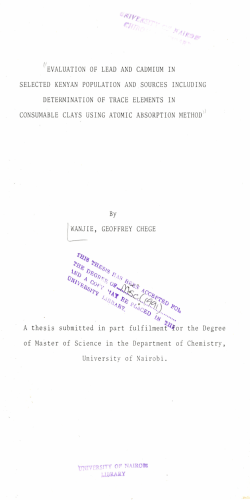
Research information - BOKU Plant Breeding / Dept. Crop Sciences
Press information Soybeans with reduced cadmium concentration: A contribution to food safety April 15, 2015 Cadmium is a toxic heavy metal present in many agricultural soils as a consequence of environmental pollution. Cadmium is readily absorbed by soybeans, durum wheat, sunflower, linseed and a number of other plants. Chronic intake of cadmium imposes a major health risk to the human body as cadmium is accumulated in the kidney causing various adverse health effects. An international research team lead by Jaroslav Hlušek, former rector of Mendel University in Brno (Czech Republic) has made an important contribution to make soybeans and soy-foods more safe. Through a collaboration between Mendel University Brno and the University of Natural Resources and Life Sciences Vienna (BOKU, Vienna, Austria), researchers have validated a genetic marker linked to a gene controlling cadmium uptake from the soil. Utilizing the marker, soybeans can be classified in either low or high cadmium accumulating varieties. Thus, soybean farmers and soy-food processors can easily select varieties low in cadmium uptake for manufacturing healthy and safe soy-food products. As several European countries in the Danube region are expanding soybean production in an attempt to increase domestic protein supply, this is a relevant finding in particular for new production regions with unknown heavy metal status of soils. The European Commission as well as Codex Alimentarius commissions have set a maximum cadmium level of 0.20 mg/kg for soybean and other food products at present. In pot experiments at Brno and in field experiments at three different locations in Austria, cadmium concentration in soybean seeds was 40-70% reduced in varieties classified as low in cadmium accumulation as compared to the high Cd accumulators. Soybean genotypes selected for the low cadmium accumulation gene had a seed cadmium concentration below the maximum level in all experiments. This underlines the efficiency of the genetic marker to characterize soybeans in terms of cadmium accumulation. Apart from food uses, the research results are also relevant to the animal feeding sector for reducing cadmium in soybean meal. The research has been published in the journal Euphytica (Springer Science+Business Media) in the May 2015 issue. A list of soybean varieties of early maturity groups and their cadmium uptake behavior according to the genetic marker is included in the publication. This research was partly supported by the bi-lateral AKTION Austria – Czech Republic research programme. Reference: J. VOLLMANN, T. LOŠÁK, M. PACHNER, D. WATANABE, L. MUSILOVÁ & J. HLUŠEK, 2015, Soybean cadmium concentration: validation of a QTL affecting seed cadmium accumulation for improved food safety. Euphytica 203:177-184. DOI - link: 10.1007/s10681-014-1297-8 Contacts for further information: Prof. Tomáš Lošák, Ph.D. Dr. Johann Vollmann Department of Environmentalistics and Natural Resources, Faculty of Regional Development and International Studies, Mendel University in Brno Division of Plant Breeding, Department of Crop Sciences, University of Natural Resources and Life Sciences Vienna (BOKU) Zemědělská 1, 613 00 Brno, Czech Republic Konrad Lorenz Strasse 24, 3430 Tulln an der Donau, Austria phone: +420 545 136 256 phone: +43 1 47654 3309 e-mail: [email protected] e-mail: [email protected]
© Copyright 2026











